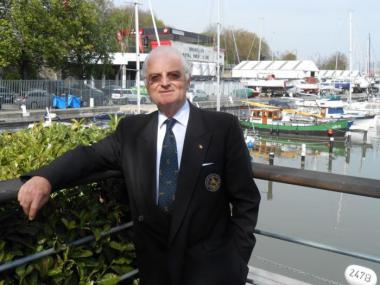
2014-04-24 – If you follow the Brussels Maritime Canal northward to the Scheldt, past the turning dock with its concrete plants, its scrap metal yards and its logistics companies, just after the Van Praet Bridge you come across a surprising sight: a small marina. Obviously this is a far cry from Marbella or St-Tropez, but even so, the vision of all those hulls and masts resplendent in the sunshine immediately gives the Canal a holiday atmosphere. This is the Brussels Royal Yacht Club, better known as BRYC.
BRYC is best known for its sailing schools. There are four of these: one runs a one-year course leading to the yachtsman’s qualification; a second runs a one-year follow-on course leading to the helmsman’s qualification; a third, also for adults, issues the qualification for yachting in international waters. Every year, around a hundred people come to BRYC one evening per week to master the very specific jargon of boating. In addition, there is a junior sailing school for young people. For a long time, this only ran holiday courses over Easter and in the summer. Since last year, however, due to increased demand, courses have also been offered on Saturday afternoons for children aged 8 to 13 years.
Those who have completed their training and wish to take things further can get involved in one-design racing in sailing dinghies. Currently, some ten teenagers and young people have reached international competitive level. BRYC only sent one representative to the London Olympics in 2012, but three or four of its past pupils will be competing at Rio in 2016! Obviously, they no longer train on the Canal: they spend 300 days a year on the water at international regattas in Europe and around the world, in what is virtually a full-time profession. They wear the colours of their club, which is affiliated with the French-speaking Federation of Yachting in Belgium.
Freshwater and saltwater sailors
We are shown round by Commodore Alain Radelet, chairman of the board of directors of this century-old institution. Of the 500 members of BRYC, only somewhat more than half own a boat. The other 220 either no longer own one (for the time being at least), or sail as part of a crew, or simply enjoy the clubhouse and its characteristic 1930s architecture, or are enrolled on courses.
This is a place where enthusiasts for boating and the accompanying social code can get together, share a good meal, and enjoy some of the activities that every club offers its members. The most spectacular of these takes place twice a year. As Brussels is a wintering port, yachts leaves in the spring in the ‘great departure’ and come back in October in the ‘great return’. In the ‘great departure’, the boats sail off in convoy towards the sea. There they separate, with some making for Zeebrugge, others for Ostend or Nieuwpoort, and others still going as far as Breskens, the first port in Zeeland waters, which is co-owned by BRYC. They then re-assemble six months later to repeat the journey in the opposite direction and swap yarns about the past holidays of an evening on the dock.
Two-day tourists
The places left vacant at BRYC are occupied during the summer by visitors from all parts: British, Dutch, Germans and Scandinavians heading towards the sun, and sailors from southern Europe in quest of the superb Nordic landscapes... The turnover is continuous, because boating is undergoing a boom. ‘From BRYC you can reach the Côte d’Azur in 200 locks and one month,’ says the Commodore. ‘That’s under motor, of course: although Brussels is a seaport, with a 30-metre clearance height, masts have to be taken down permanently at the Van Praet Bridge if you are heading up the Canal.’ These visitors tend to stay for no more than a day or two in the capital before making off for new horizons. Actually, ‘making off for new horizons’ is putting it a little strongly: what appeals to these Sunday sailors is pottering slowly along, enjoying the proximity of the surrounding countryside.
In dock, they will have made the most of the comprehensive facilities offered by BRYC, including bathrooms, washing machines, wifi and a petrol and diesel station. Repairs can also be made if necessary: there are two cranes, a trailer and a workshop available, as well as a port master, Alain De Cock, who is ready to lend a word of advice and a hand.
Bread and circuses
Another great event, organised every other year, is the Port of Brussels Festival in May. The marina’s premises are opened to the public and pupils of the junior sailing school provide demonstrations and try to inspire new recruits. There are also motor boat trips. In fine weather, the event attracts a lot of interest.
Last year, Bruxelles-les-Bains also arranged for demonstrations to be organised. The Commodore has not yet received a request for the coming season.
Apart from these major events, the club also puts on occasional musical evenings for its members and monthly lectures on topics such as the history of the naval wars between France and England, racing yacht design, or an account of a voyage through the Northwest Arctic by a family with four children - under sail! Alain Radelet admits that he personally would not have taken on such a challenge…
An all-rounder
All the same, this is a man of considerable experience. Before getting into yachting, he was a high-level hockey player until the age of 40, playing in a top division team and then at international level. When he realised he was past his peak, he looked for another hobby and enrolled in the sailing school. He is thus a pure product of BRYC! His boat – it is his third – is a 13-metre motorised yacht moored in the Mediterranean. With his two children and his wife, he uses it as a place for family gatherings. ‘We explore Corsica, Sardinia, the Tuscan islands. It’s like bringing your hotel room with you as you visit places. But we sleep in the port at night – it’s more comfortable,’ he smiles.
Alain Radelet qualified as a civil engineer and had a career in business, running the Van Rymenant group, then Maurice Delens, and finally Eiffage over the course of 24 years. He was then managing director of Société Espace Léopold, which was responsible for the 600,000 m² of offices and housing around the Gare du Luxembourg and the European Parliament. After such a career, how can you contemplate retirement? So it was that he wound up as president of a business training institute, the SBPA, and vice-president of the Brussels Harbour Community Organisation. He is thus well-acquainted with the Canal.
Equity and subsidies
So what about the management of the club? BRYC is located on land owned by the Belgian Royal Trust, with a long lease that has just been renewed until 2029. The water and the docks are under lease from the Port of Brussels until 2018. The building is owned by the club, as are the boathouse and other buildings.
When the directors, all of whom are volunteers, gather for their monthly meeting, their task is to oversee maintenance, renovation and modernisation work. The outlay must be considerable, and has to be covered from membership fees, rental income and various state subsidies. The infrastructure also attracts support from the French Community Commission, COCOF, for minor sports facilities (boathouses, electrical renovation of the port, garage roof, etc.). The sailing schools benefit from funding from the French Community sporting authority ADEPS for the purchase of boats. ‘But all these forms of support consist of (partial) reimbursements of invoices, with delays from 15 to 24 months, and the board sometimes faces liquidity problems,’ sighs Alain Radelet. He concludes on a philosophical note: ’As often where budgets are concerned, you have to strike a subtle balance.’
Last event of the season
By the time you read this, the grand departure will already have taken place, but do not miss the grand return on 26 and 27 October. BRYC, which sponsors the event, has announced that the Zénobe Gramme, the naval training yacht, will be present. This could well be the boat’s last outing before it is decommissioned, as the Belgian navy can no longer afford the costs. Training will doubtless have to be organised on foreign yachts from now on, and for sailing enthusiasts such as Commodore Radelet this represents a sad loss indeed.
Véronique Kirszbaum
Meer info: www.bryc.be

















